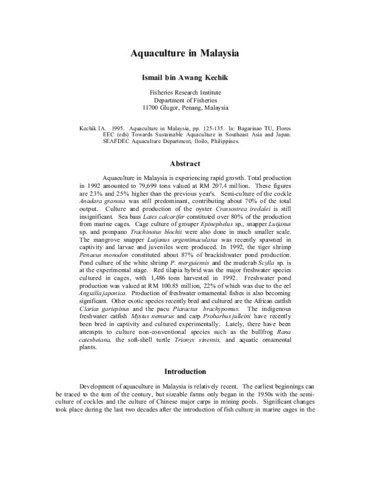A critical review of shrimp pond culture in the Philippines
- Global styles
- MLA
- Vancouver
- Elsevier - Harvard
- APA
- Help

View/
Date
1993Author
Page views
3,023ASFA keyword
AGROVOC keyword
Metadata
Show full item record
Share
Abstract
The paper reviews and evaluates shrimp pond culture in the Philippines and its ecological and socioeconomic effects. The intertwined histories of the country's mangrove forests and culture ponds are treated in depth; brackishwater aquaculture and the different shrimp culture systems are described. Intensive farming is discussed in terms of feed and water requirements, chemical inputs and waste production, and the attendant organic and nutrient overloading, longevity and toxicity of chemicals, development of antibiotic resistance, and introduction of exotic species. Most of the discussion is based on the Philippine experience, but relevant case studies from other shrimp‐growing countries, notably Thailand and Indonesia, and also from salmon cage culture in the temperate zone, are included.
Ecologically and economically more viable, semi‐intensive culture is recommended as the key to the long‐term sustainability of the shrimp industry. Because the greatest impact of brackishwater pond culture (including shrimp farming) is the loss of mangrove habitats and their varied goods and services, massive reforestation of degraded areas should be undertaken. Other recommendations are the promotion of environmentally sound aquaculture technologies, e.g., seaweed and mollusc culture and the integrated forestry‐aquaculture‐fisheries management of mangrove plantations (tumpang sari) in coastal areas; enforcement of existing laws that protect remaining mangroves; and promulgation of new laws to regulate water use and waste disposal. Areas for future research include the prevention and control of pond wastes and shrimp diseases, and refinements of the Indonesian tumpang sari for adoption locally.
Suggested Citation
Primavera, J. (1993). A critical review of shrimp pond culture in the Philippines. Reviews in Fisheries Science , 1(2), 151-201. https://doi.org/10.1080/10641269309388539
Type
ArticleISSN
1064-1262Collections
- Journal Articles [1258]
Related items
Showing items related by title, author, creator and subject.
-
Aquaculture in Malaysia
Kechik, Ismail bin Awang. (Aquaculture Department, Southeast Asian Fisheries Development Center, 1995)Aquaculture in Malaysia is experiencing rapid growth. Total production in 1992 amounted to 79,699 tons valued at RM 207.4 million. These figures are 23% and 25% higher than the previous year's. Semi-culture of the cockle ... -
Aquaculture development in Thailand
Sirikul, Boonsong; Luanprida, Somsak; Chaiyakam, Kanit; Sriprasert, Revadee (Aquaculture Department, Southeast Asian Fisheries Development Center, 1988)Aquaculture practised in Thailand is in the form of pond culture and cage culture in freshwater, brackishwater and coastal areas. The main species cultured include freshwater prawns, brackishwater shrimp, cockles, mussels, ... -
The Philippine aquaculture industry
Camacho, Arsenio S.; Macalincag-Lagua, Natividad (Aquaculture Department, Southeast Asian Fisheries Development Center, 1988)The aquaculture sector of the Philippine fishing industry registered the highest growth rate of 12.5% in 1977-1986. The contribution of aquaculture to the total fish production was equivalent to 24% in 1986 compared to ...





